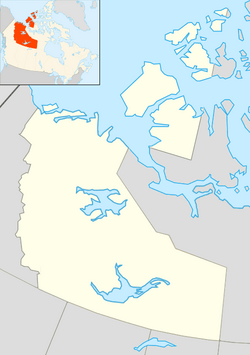Wrigley, Northwest Territories facts for kids
Quick facts for kids
Wrigley
Pedzéh Kñ
|
|
|---|---|
|
First Nation (Designated Authority)
Pehdzeh Ki First Nation |
|
| Country | Canada |
| Territory | Northwest Territories |
| Region | Dehcho Region |
| Constituency | Nahendeh |
| Census division | Region 4 |
| Settled | 1965 |
| Area | |
| • Total | 55.84 km2 (21.56 sq mi) |
| Elevation | 149 m (489 ft) |
| Population
(2016)
|
|
| • Total | 119 |
| • Density | 2.1/km2 (5/sq mi) |
| Time zone | UTC−07:00 (MST) |
| • Summer (DST) | UTC−06:00 (MDT) |
| Canadian Postal code |
X0E 1E0
|
| Telephone exchange | 581 |
| - Living cost | 152.5 |
| - Food price index | 173.6 |
| Sources: Department of Municipal and Community Affairs, Prince of Wales Northern Heritage Centre, Canada Flight Supplement 2013 figure based on Edmonton = 100 2015 figure based on Yellowknife = 100 |
|
Wrigley is a small community in the Northwest Territories, Canada. Its name in the South Slavey language is Pehdzeh Ki, which means "clay place". It is located in the Dehcho Region.
Wrigley is on the east side of the Mackenzie River. This river is one of the longest in North America. The community is also near the Wrigley River. It is about 466 miles (750 km) northwest of Yellowknife, the capital city.
The people who live in Wrigley are mostly Slavey Dene. They continue to live a traditional lifestyle. This includes activities like trapping, hunting, and fishing.
Contents
History of Wrigley
The community of Wrigley was not always in its current spot. It used to be about 10 miles (16 km) downstream. This old location was called Fort Wrigley.
In 1965, the community moved. One reason was that the new spot was easier to reach. It was close to the Wrigley Airport. This airport was built during World War II for a big project called the Canol Project. Also, the land at Fort Wrigley was quite swampy.
Today, you can get to Wrigley by driving on the Mackenzie Highway.
How Wrigley Got Its Name
Wrigley was named after a man named Joseph Wrigley. He was an important person in the Hudson's Bay Company. This company was very famous for trading furs in Canada. Joseph Wrigley was their Chief Commissioner for British North America from 1884 to 1891.
Nature and Mountains
The Franklin Mountains are right next to Wrigley. They are also on the east side of the Mackenzie River. These mountains are a beautiful sight overlooking the community.
Cap Mountain is the tallest peak in the Franklin Mountains. It is 1,228 meters (4,029 feet) high. You can even walk to it from Wrigley!
There are also special sulphur springs downstream from Wrigley. They are called Roche qui trempe a l’eau. These springs are not as famous as the Rabbitkettle Hot Springs, but they are still a natural wonder.
People of Wrigley
In 2021, about 117 people lived in Wrigley. Most of the people (110 in 2016) are First Nations. The main languages spoken are North and South Slavey and English.
First Nations Community
The Dene people in Wrigley are part of the Pehdzeh Ki First Nation. They are also connected to the larger Dehcho First Nations group.
An important historical event happened here. The last of the Numbered Treaties, called Treaty 11, was signed in Wrigley on July 13, 1921. Treaties are agreements between the government and First Nations peoples.
Community Services
Wrigley has a few important services for its residents.
- There is one local store where people can buy supplies.
- The community has a health centre. This is where people can go for medical care.
- There is also a small Royal Canadian Mounted Police (RCMP) office. Two police officers work there to help keep the community safe.
Education in Wrigley
Kids in Wrigley go to Chief Julian Yendo School. This school teaches students from kindergarten up to grade 9. In 2018, there were 24 students enrolled.
After finishing grade 9, students travel to Fort Simpson. They attend Thomas Simpson Secondary School there to continue their high school education.
Climate
Wrigley has a subarctic climate. This means it has very long and cold winters. The summers are short, but they can be mild to warm.
For example, in January, the average high temperature is around -21°C (-6°F). In July, the average high temperature is around 23°C (73°F). This shows a big difference between the coldest and warmest parts of the year!
Images for kids




